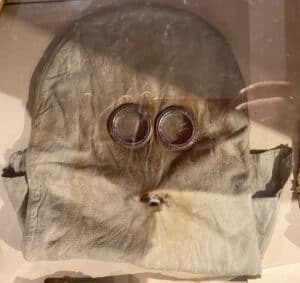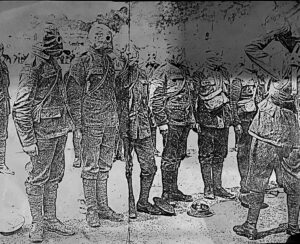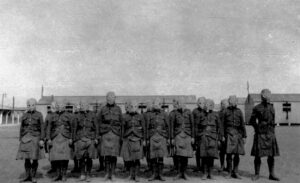Early version of gas mask for British and Canadian forces. Missing is the purifying cartridge to be attached to the device on the front. First widely distributed version of the gas mask to Canadian forces. In dire situations the cartridge attachment hole could be used in conjunction with the shell dressing kit to have a make-shift cartridge by urinating on the gauze rolling it up and stuffing the gauze in the cartridge hole.
The mask forms a sealed cover over the nose and mouth, but may also cover the eyes and other vulnerable soft tissues of the face. Most gas masks are also respirators, though the word gas mask is often used to refer to military equipment (such as a field protective mask), the scope used in this article. The gas mask only protects the user from digesting, inhaling and contact through the eyes (many agents affect through eye contact). Most combined gas mask filters will last around 8 hours in a nuclear biological chemical (NBC) situation. Chemical specific filters can last up to 20 hours in an NBC situation.
Airborne toxic materials may be gaseous (for example, mustard gas and chlorine gas) or particulates (such as biological agents). Many filters include protection from both types.
The German army used poison gas for the first time against Allied troops at the Second Battle of Ypres, Belgium on April 22, 1915. As an immediate response, cotton wool wrapped in muslin was issued to the troops by 1 May and followed by the Black Veil Respirator, a cotton pad soaked in an absorbent solution which was secured over the mouth using black cotton veiling. Seeking to improve on the Black Veil respirator, Colonel Cluny Macpherson created a mask made of chemical absorbing fabric and which fitted over the entire head. A 19.9” × 18.9” canvas hood treated with chlorine-absorbing chemicals, and fitted with a transparent mica eyepiece. Macpherson presented his idea to the War Office Anti-Gas Department on May 10, 1915, with prototypes being developed soon after. The design was adopted by the British Army and introduced as the British Smoke Hood in June 1915; Macpherson was appointed to the War Office Committee for Protection against Poisonous Gases. More elaborate sorbent compounds were added later to further iterations of his helmet (PH helmet), to defeat other respiratory poison gases used such as phosgene, diphosgene and chloropicrin.



